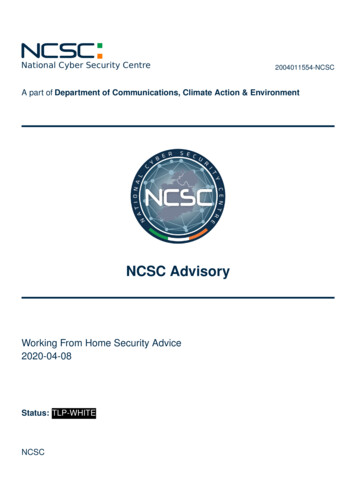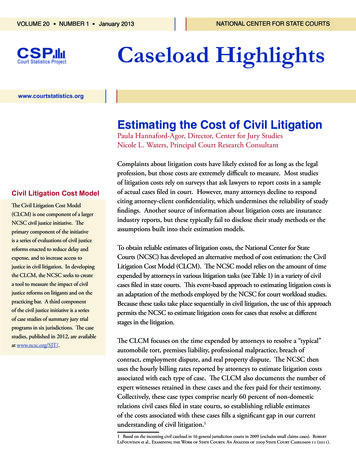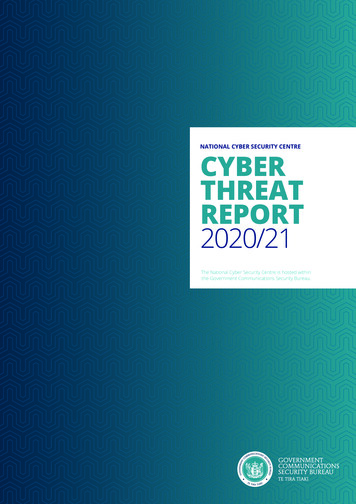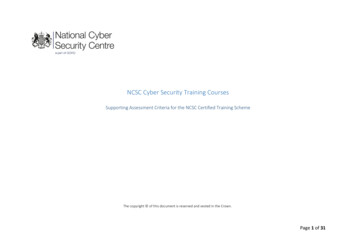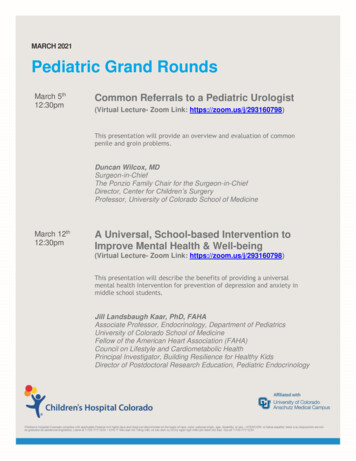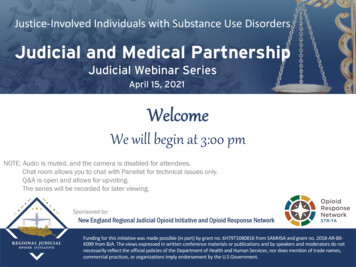
Transcription
Justice-Involved Individuals with Substance Use DisordersJudicial and Medical PartnershipJudicial Webinar SeriesApril 15, 2021WelcomeWe will begin at 3:00 pmNOTE: Audio is muted, and the camera is disabled for attendees.Chat room allows you to chat with Panelist for technical issues only.Q&A is open and allows for upvoting.The series will be recorded for later viewing.Sponsored by:New England Regional Judicial Opioid Initiative and Opioid Response NetworkFunding for this initiative was made possible (in part) by grant no. 6H79T1080816 from SAMHSA and grant no. 2018-AR-BXK099 from BJA. The views expressed in written conference materials or publications and by speakers and moderators do notnecessarily reflect the official policies of the Department of Health and Human Services, nor does mention of trade names,commercial practices, or organizations imply endorsement by the U.S Government.
Agenda & PresentersWelcomeChief Justice Paul Suttell, Rhode IslandPlenaryChris Herren, Former Professional BasketballPlayer & Wellness Advocate, Rhode IslandStigma and LanguageEric Haram, LADC, Haram Consulting, MaineJudicial Perspective:Practical Application for JudgesChief JusticePaul Suttell, RIChris Herren, RIJudge Kathleen Coffey, MassachusettsClosing RemarksActing Chief Justice Andrew M. Mead, MaineEric Haram, MEHonorableKathleen Coffey, MAActing Chief JusticeAndrew Mead, ME
PlenaryChris HerrenFormer Professional Basketball Player &Wellness Advocate, Rhode Island
Substance Use Disorders andthe Judicial System:Changing our language toReduce Stigma and Bias in the Justice SystemEric Haram, LADCApril 15, 2021
Working with communities toaddress the opioid crisis.² SAMHSA’s State Targeted Response Technical Assistance(STR-TA) and State Opioid Response Technical Assistance(SOR-TA) grants created the Opioid Response Network to assiststates, individuals and other organizations by providing theresources and technical assistance they need locally toaddress the opioid crisis.² Technical assistance is available to support the evidence-based prevention, treatment, and recovery of opioid usedisorders.Funding for this initiative was made possible (in part) by grant nos. 6H79TI080816 and 1H79TI083343 from SAMHSA.The views expressed in written conference materials or publications and by speakers and moderators do notnecessarily reflect the official policies of the Department of Health and Human Services; nor does mention of tradenames, commercial practices, or organizations imply endorsement by the U.S. Government.5
Working with communities toaddress the opioid crisis.² The Opioid Response Network (ORN) provides local,experienced consultants in prevention, treatment andrecovery to communities and organizations to help addressthis opioid crisis.² The ORN accepts requests for education and training.² Each state/territory has a designated team, led by aregional Technology Transfer Specialist (TTS), who is anexpert in implementing evidence-based practices.6
Contact theOpioid Response Network² To ask questions or submit a request for technicalassistance: Visit www.OpioidResponseNetwork.org Email orn@aaap.org Call 401-270-59007
Learning Objectives² Discuss stigma, substance use disorders (SUDs), thejudiciary and the importance of Person Centered, nonstigmatizing language.² Conceptualize and understand the different types ofstigma: Individual or Self-Stigma, Institutional and Socialstigma, as well as the role of Bias, Discrimination, andRacism.² Address misconceptions about Evidence-Based Practiceswithin the judicial intersections of law and medicine andhow these contribute to bias and stigma about SUDs.
Imagine ² You are visiting with your sister after a recent court appointmentfor her daughter for violating probation, possessing alcohol.² The judge asked your niece how she could be so foolish to lether addiction get so out of control again.² The judge agreed with the probation officer’s recommendationand said, she didn’t seem to really be trying she could gainsome self control while in jail.² The judge said once she does that, he will consider an orderedalcoholism assessment covered by the county.² The judge also tells her that treatment will not do her any goodunless she really is ready, and he will know that if she drops 3clean drug tests and alcohol swabs by the scheduled date.Slide Credit: UCLA Integrate Substance Abuse Programs9
What impact might this have?² For the person with a substance use disorder (SUD)² For her family² For the judge and systemSlide Credit: UCLA Integrate Substance Abuse Programs10
The Negative Power of Stigma² No other medical condition is shrouded in stigma likesubstance use disorders² It affects those who are suffering, their loved ones, andoften numerous others² Due to this stigma, those in need of treatment do not seekmedical attention² Substance use disorder - one of the most misunderstoodand mischaracterized health conditionsSlide Credit: UCLA Integrate Substance Abuse Programs
The Justice System is the Single LargestSource for Referral to (SUD) Treatment,After Self-referrals² Stigma can drive people away from seeking the help theyneed. Research indicates that it is one of the mostsignificant barriers to seeking and remaining in treatment.² For those suffering from substance use disorder, theparticular words used by the judge are an importantcomponent of that interaction. An inappropriate choiceof words can contribute to stigma.The National Judicial Opioid Task Force. Words Matter, Feb. 201912
Paying Attention to Language IsNot About Political Correctness² It is about doing all one can to increase access to qualitytreatment and care.² In cases involving drug/alcohol use, an appropriate choiceof words can make the difference between reinforcingnegative stereotypes and promoting positive change.² A review of literature on this topic overwhelminglyencourages the use of language that reflects the medicalnature of SUDs and promotes recovery.The National Judicial Opioid Task Force. Words Matter, Feb. 201913
Judges Play a Significant Rolein the Nation’s Response to SUDs² A judge’s role to remain impartial, but not indifferent,can often be difficult. In the face of behavior that canseem outrageous or ambivalent, words have power.² The National Judicial Opioid Task Force supports andrecognizes Language Matters and encourages the use ofrespectful language to describe SUD and those who usedrugs. To this end, judges should consider “changingthe script.”The National Judicial Opioid Task Force. Words Matter, Feb. 201914
Language and Stigma² Language can bind us together or tear us apart² Words we choose in personal and professional settings leavepowerful and indefinitely impact impressions² The language we use can play a significant role in stigmareduction– Too often, language unintentionally strengthens harmfuleffects, “If they know you used drugs, nobody is going to helpyou. They just think you will lie about everything.”² How we talk about SUDs matters² Best to unify a common language, appropriate terminology, andprecise definitionsSlide Credit: UCLA Integrate Substance Abuse Programs
‘Substance Abuse’:Changing the NarrativeChild abuse, spousal abuse, sexual abuse—these are criminal acts carried out byindividuals. Calling a substance use disorder“substance abuse,” or calling people with usedisorders “substance abusers,” furthercriminalizes a treatable health condition,perpetuates stigma, and delegitimizessubstance use disorders as a medical matizing-language16
Stigmatizing Language²You may use stigmatizing terms every day²Most may not realize the extent of their negative impact²Think about the negative sentiment attached to each of the following:“He is a drug addict.”“She can’t seem to get clean.”“Our community has a serious addiction problem.”“He can’t seem to avoid relapse.”“The client had a dirty urine.”What alternatives can you think of?Slide Credit: UCLA Integrate Substance Abuse Programs
LanguageNegativePositiveSubstance AbuserPerson who uses substancesRelapseRecurrence of doseAccidental drug poisoningAddictAlcoholicOpioid AddictSlide Credit: UCLA Integrate Substance Abuse ProgramsPerson with a substanceuse disorder
Health In Justice Lab,Northeastern University School of Law
What is Stigma?Stigma1a: a mark of shame or discredit: Stainb: an identifying mark or characteristic;specifically: a specific diagnostic signof a disease- Merriam-Webster DictionarySlide Credit: UCLA Integrate Substance Abuse Programs
What is Stigma,Discrimination, and Racism?² Stigma refers to negative stereotypes – an attribute, behavior,or condition, that is socially discrediting.² Discrimination is the behavior that results from the negativestereotype.² Racism is the erroneous belief that different races possessdifferent characteristics, abilities, or qualities which distinguishthem as superior or inferior to one anotherHEALTHYPLACE.COMCatherine Chichester, APRNBC, CCSME 2019
Implicit BiasUnconscious attitudes or stereotypesthat affect our understanding, actions, and decisions.We are poor at seeing bias in ourselves, but good at seeing it in others. Due to this,there is real power in groups and teams taking on bias together: naming the biases,being transparent, and holding each other accountable.Individual experiences:“This court has been seeing my family for a generation, they are never going to believeanything I have to say I didn’t ask to be in a family where alcoholism and domesticviolence are handed down like a crown They will not let me take my suboxone in jail, everyone switches to vivitrol if they stay inthis program The last thing I’ll do is tell the court I have a drug problem. Nobody’s going to help meif they know that’s the problem.”- Ashford, RD, Brown. AM & Curtis, B (2018): The Language of Substance Use and Recovery:Novel Use of the Go/No–Go Association Task to Measure Implicit Bias. Health Communication.Slide Credit: UCLA Integrate Substance Abuse Programs
Institutional Stigma² Structural practices, intended or unintended, that restrictcertain individuals or groups from community or governmentalopportunities based upon policies, practices, and traditions.² The disapproval of, or discrimination against, a person based onperceivable social, racial, or cultural characteristics that serve todistinguish them from other members of a society.² Covid-19 has revealed the sweeping inequity in healthcareaccess, reach of public health education, and outcomes alongracial lines. Disproportionate overdose deaths, Covid-19hospitalizations, and deaths are examples of inequitable accessto standard treatments, hampered by structural bias, stigma,discrimination, and racism.
Stigma and Self-Stigma²Self-stigma results in part from publicjudgement in a process leading to theinternalizing of negative stereotypes.²Profound shame, guilt, and idealizedperceptions inhibit help-seeking behaviorand are frequently misinterpreted or judgedas signs of apathy.²Missed appointments, defensive posture,avoidance, escalation, and lack of selfadvocacy are examples of shame-influencedbehaviors.Stigmatization of People with Mental Illness, Arthur H. Crisp, Michael G. Gelder, Susannah Rix, Howard I Meltzer and Olwen J. Rowlands,British Journal of PsychiatryStigma and Self-Stigma in Addiction Steve Matthews & Robyn Dwyer & Anke SnoekCatherine Chichester, APRNBC, CCSME 2019
Stigma Interacts with Systemsand Distorts OutcomesI struggle [with] people offering me help, I still thinkthat I’m not worthy of it ’cause they . everyone’s beenoffering me to help move and I said, no, it’s alright manI’ll get a taxi, or I’ll carry it, or whatever, and yeah, theguy the guy at [treatment service] said the other dayhe sees it as me being me myself thinking I’m notworthy of anyone’s help.I know better than to tell them what’s really going on.Once we start something good, we feel guilty becausewe feel like we don’t deserve it.Catherine Chichester, APRNBC, CCSME 2019
Opioid Use Disorder is a Deadly Disease“Retention in methadone and buprenorphine treatment isassociated with substantial reductions in the risk for all causeand overdose mortality in people dependent on opioids.”² Reviewed 19 observational studies- BMJ, April 2017² Involving more than 120,000 patients² Mortality increased after people discontinued medicationsfor opioid use disorder² Over 81,000 deaths from accidental poisoning (overdose)in 2020Carla Marienfeld, MD ORN STR-TA 2019
What Can Judges Do?² Avoid stigmatizing labels/words - Practice² Seek consultation² Educate – self, colleagues, coworkers, community² Recognize symptoms, warnings, “red flags”² Treat with dignity and respect² Encourage treatment² Become Trauma-Informed² Not blame a victim for an underlying SUD or MH condition² Partner with Recovery Support Services/Recovery Coaches² Speak up about hopeful stories and successes
Evidence-Based Practicesfor Substance UseDisordersand PersonalBeliefs/BiasSlide Credit: UCLA Integrate Substance Abuse Programs28
“Why are ‘they’ like that and can anything help?”² The lack of knowledge about the biological and socialfactors contributing to SUDs is an overall driver of stigmaand bias.² There are well researched, proven standards of care to treatSUDs and sustain long-term recovery.² Knowledge and understanding about etiology and effectivetreatment promotes an elevated, more respectful andhopeful conversation.² You will be provided more in-depth information about theevidence base for effective treatment over the course ofthis event.29
Adverse Childhood Experiences andAdverse Community Environments
Therapeutic Jurisprudence:Becoming Trauma-Informed² A trauma-informed approach to jurisprudence includes anunderstanding of trauma and an awareness of the impact itcan have across settings, services, and populations.² It involves viewing trauma through an ecological andcultural lens and recognizing that context plays asignificant role in how individuals perceive and processtraumatic events.
Why Is Understanding Trauma Important?Effects On an Individual’s Engagement² Individuals who have experienced trauma are often sensitiveto triggers in the environment. We need to understand andhelp individuals feel safe rather than distressed.² Avoidance of services² Difficulty adhering to plans² Postponing services until issues are critical² Misuse of medical treatment services, for example – overuseof ED services and misuse of pain medication, othercontrolled substances, and alcohol
MOUD: The Standard of Carefor Opioid Use Disorder²MOUD is the integration of FDA-approved medications tostabilize, treat, and maintain sustained remission from opioiduse disorder.²Medications include Methadone, Buprenorphine, andNaloxone/Vivitrol.²Methadone Maintenance Treatment (MMT) remains the moststudied intervention for the treatment of opioid addiction.²All the FDA-approved medications greatly improve mortalityrates, treatment outcomes, and sustained remission fromopioid addiction.
Medication and MaintenanceAre Needed for Success**20% of control group died(Kakko et al., 2003)
Robin E. Clark et al.,“The Evidence Doesn't Justify Steps by State Medicaid Programsto Restrict Opioid Addiction Treatment with Buprenorphine,”Health Affairs 30, no. 8 (2011): 1425-33, doi:10.1377/hlthaff.2010.0532.²²²In a study of 33,923 Medicaid patients diagnosed with opioiddependence in Massachusetts, mortality during the four-yearstudy period (2003-2007) was double among patients receivingno treatment versus patients treated with buprenorphine.Patients treated with buprenorphine experienced a 75%reduced mortality versus patients treated with psychosocialinterventions alone.Does stigma and bias have an influence on access totreatment? This study was conducted 15 years ago andpublished 10 years ago.
How Lack of Knowledge About Evidence-Based TreatmentPerpetuates Stigma, Bias, and Distorts Outcomes²²²²²²38 yr. old single mom of 2 children, opioid addiction w/co-occurringanxiety and trauma2 years in a drug treatment court – 4 relapses w/opioids, 3 near-fataloverdoses, and referred to withdrawal management and short-termresidential treatmentActions included brief incarcerationUse of incarceration to achieve physical safety/lethality of overdosepotential while awaiting “MOUD Free” Residential Treatment bedFollowing 3rd overdose, discharged from court program pendingprison sentence for trafficking heroinNever referred to MOUD, actively dissuaded from pursuing MOUD –will result in discharge.
Court Participant Sketch:Bias-Driven vs. Evidence-Based Cost and EfficacyBias-DrivenIn this sketch, the client was incarceratedfour times for a total of 37 days:Ø 75 dollars/day x 37 days 2,775Ø 800 for an ambulance ride 1,200 foran ED admit, 3 times 6,000Ø 1,400/day for detox for 5 days 7,000Ø 4,800 per discharge from “MOUD Free”residential treatment, 3 times 14,400Ø Total Cost for 2 years of opioid usedisorder treatment without MOUDwhile in a Court Program 30,175Evidence-BasedCompared to:Ø One year of ambulatory treatmentintegrated w/MOUD servicesØ IOP 8-12 weeks ( 4,000) OutpatientGroup Therapy 18-24 weeks ( 1,320) Medication, buprenorphine ( 4,800) 10,120/yearØ Return-to-use rates for OUD decreasefrom 85% in “MOUD FREE” residential to40% in ambulatory services withIntegrated MOUDØ Half the Cost, Double the Improvement
Why It Matters² Conceptualizations/related terminology implicitly reflect andinfluence how we think about and approach SUDs² Language standardized collection of symbols that triggernetworks of cognitive scripts, activating chains of thoughts;influences appraisal, attitudes, actions² Language changes over time; from “lunatic asylums”and“drunkards/dipsomaniacs” to “psych hospital” and “Personwith a Substance Use Disorder”² Policy approaches to “drug problem” possess own rhetoric –shift from “War on drugs” (punishment) to public healthemergency (prevention/treatment) Catherine Chichester, APRNBC, CCSME 2019
Core Messages for Judges“Persons in recovery from SUDs are part of my community.”“Recovery has brought stability to [his/her] life.”“Long-term recovery helps to empower those in recovery andenhances our community.”“Long-term recovery has given them and our community newpurpose, creating a culture of support and assistance.”“Our language and our efforts to continually improve it, make itpossible for everyone to enhance their quality of life, whilepursuing personal goals and successes.”
Putting It All TogetherTraining, Competency, and Confidence – Practice, Practice, Practice²The judiciary makes a difference in the nation’s problem with SUDs andaccidental poisonings (overdose deaths).²Understanding the social and biological factors that contribute to SUDs is acritical step in reducing stigma and bias.²Words matter, they have great power to make or break a person’s resolve toengage in a pathway toward recovery.²Articulate scientific findings demonstrating improved treatment outcomesw/mortality and cost containment in health and public safety.²Practice changes in language within your courts or teams, make agreements topoint out language that is stigmatizing or lacks a trauma-informed lens.²Explore your own implicit bias and make commitments and time to discussamongst your colleagues. (See pg. 4 of pdf: e/files/inline-files/QC Words%20Matter SUD%20ConversationGuide 2018.pdf.)
Stigma ResourcesNIDA Med Words MatterBreaking Through the Wall of StigmaNIH HEAL Research Aims to Address Stigma41
References And ResourcesFelitti VJ, Anda RF, Nordenberg D, Williamson DF, Spitz AM, Edwards V, Koss MP, et al. (1998). The relationship of adult health status tochildhood abuse and household dysfunction. American Journal of Preventive Medicine. 1998; 14: pp. 245258.Ligenza, L. (2012). Trauma-Informed Care in an integrated world. Retrieved from mmunity/TraumaInformed Care in an Integrated World for CIHS 8 27-12 all edits.pdfNational Council of Juvenile and Family Court Judges. (n.d.). ACE questionnaire. Retrieved ding%20Your%20ACE%20Score.pdfCDC Resources - out.htmlSAMHSA resources on Trauma-Informed Care - ational Child Traumatic Stress Network - https://www.nctsn.org/Fiellin DA, Schottenfeld RS, Cutter CJ, Moore BA, Barry DT, O'Connor PG. Primary care-based buprenorphine taper vs maintenance therapyfor prescription opioid dependence: a randomized clinical trial. JAMA Intern Med 2014;174(12):1947-1954.Fudala PJ, Bridge TP, Herbert S, et al. Office-based treatment of opiate addiction with a sublingual-tablet formulation of buprenorphine andnaloxone. N Engl J Med 2003;349(10):949-958.Heinrich CJ, Cummings GR. Adoption and diffusion of evidence-based addiction medications in substance abuse treatment. Health Serv Res2014;49(1):127-152.Hussey P, Anderson GF. A comparison of single- and multi-payer health insurance systems and options for reform. Health Policy (New York)2003;66(3):215-228.Krupitsky E, Zvartau E, Blokhina E, et al. Randomized trial of long-acting sustained-release naltrexone implant vs oral naltrexone or placebofor preventing relapse to opioid dependence. Arch Gen Psychiatry 2012;69(9):973-981.Mattick RP, Kimber J, Breen C, Davoli M. Buprenorphine maintenance versus placebo or methadone maintenance for opioid dependence.Cochrane Database Syst Rev 2014;2.(U.S. Department of Health & Human Services)Rudd RA, Seth P, David F, Scholl L. Increases in Drug and Opioid-Involved Overdose Deaths — United States, 2010–2015. MMWR Morb MortalWkly Rep. ePub: 16 December 2016. DOI: http://dx.doi.org/10.15585/mmwr.mm655051e1
References And ResourcesSubstance Abuse and Mental Health Services Administration, Center for Behavioral Health Statistics and Quality. (2015). Behavioral healthtrends in the United States: Results from the 2014 National Survey on Drug Use and Health. Rockville, MD: Substance Abuse and MentalHealth Services Administration.Jones CM. Heroin use and heroin use risk behaviors among nonmedical users of prescription opioid pain relievers - United States, 20022004 and 2008-2010. Drug Alcohol Depend. 2013 Sep 1;132(1-2):95- 100. doi: 10.1016/j.drugalcdep.2013.01.007. Epub 2013 Feb 12.Gabbard G. Treatments of Psychiatric Disorders, 5th Edition. Schottenfeld R, Marienfeld C. Opioid-Related Disorders: AgonistMaintenance Treatment. 2014.Evans JL, Tsui JI, Hahn JA, et al: Mortality among young injection drug users in San Francisco: a 10-year follow-up of the UFO study. Am JEpidemiol 175(4):302–308, 2012 22227793Williams, D. A., & Lemke, T. L. (2012). Foye's principles of medicinal chemistry. 7th Edition. Philadelphia: Lippincott Williams & Wilkins.Thomas R. Kosten, M.D. and Tony P. George, M.D. The Neurobiology of Opioid Dependence: Implications for Treatment. Sci PractPerspect. 2002 Jul; 1(1): 13–20.Dole VP, Nyswander ME. Heroin Addiction—A Metabolic Disease. Arch Intern Med. 1967;120(1):19-24.Keuhn B. Methadone at 40 years. JAMA Vol 294, No. 8, Aug24/31, 2005McGlothlin WH, Anglin MD. Shutting off methadone: cost and benefits. Archives of General Psychiatry 1981;38:885-92.Metzger DS, Woody GE, McLellan AT, O'Brien CP, Druley P, Navaline H, et al. Human immunodeficiency virus seroconversion amongintravenous drug users in- and out-of-treatment: an 18-month prospective follow-up. Journal of Acquired Immune Deficiency Syndrome1993;6:1049-56.BMJ 2017; 357:j1550 Mortality risk during and after opioid substitution treatment: systematic review and meta-analysis of cohort studies.https://doi.org/10.1136/bmj.j1550 (Published 26 April 2017)Tara Gomes, PhD; Mina Tadrous, PharmD, PhD; Muhammad M. Mamdani, PharmD, MA, MPH; J. Michael Paterson, MSc; David N. Juurlink,MD, PhD. The Burden of Opioid-Related Mortality in the United States. JAMA Network Open. .0217Hedegaard H, Miniño AM, Warner M. Drug overdose deaths in the United States, 1999–2017. NCHS Data Brief, no 329. Hyattsville, MD:National Center for Health Statistics. 2018.AMSP 201743
Upcoming WebinarsThursday, May 6, 2021 / 3-5p EDTThursday, May 27, 2021 / 3-5p EDTWelcomeWelcomeAssociate Justice Karen Carroll, VTChief Justice Kimberly Budd, MAScience of AddictionEvidence-Based Treatment InterventionsDr. Brian Fuehrlein, Yale School of Medicine, CTDr. John Brooklyn, University of Vermont MedicalCenter, VTJudicial Perspective:Practical Application for JudgesJudge Janet McGuiggan, MACo-occurring Disorders and Trauma:What a Judge Needs to KnowDr. Lisa Callahan, Policy Research AssociatesJudicial Perspective:Practical Application for JudgesChief Justice Paula Carey, MAClosing RemarksChief Justice Richard A. Robinson, CTJudicial Perspective:Practical Application for JudgesSAVE THE DATEThursday, June 17, 20213-5p EDTClosed Question Forums By StateState-specific registration links andinformation will be announced.Judge Kathleen Coffey, MARecovery Processes:Is Recovery Abstinence?Dr. John Kelly, Harvard School of Medicine, MAJudicial Perspective:Practical Application for JudgesChief Justice Tina Nadeau, NHClosing RemarksChief Justice Gordon MacDonald, NHwww.ncsc.org/nerjoiREGISTRATION LINKSMay 6thhttps://zoom.us/webinar/register/WN Nps1a4DiSQec-pAhKIgPmQMay 27thhttps://zoom.us/webinar/register/WN 2o0AoouBS92OFnTeD0LYJA
Justice-Involved Individuals with Substance Use DisordersJudicial and Medical PartnershipJudicial Webinar SeriesApril 15, 2021Thank you for joiningPlease complete the survey sent via email.Note: Proof of attendance for CLE credit will be sent through email.Contact: Kristina Bryant (kbryant@ncsc.org)Sponsored by:New England Regional Judicial Opioid Initiative and Opioid Response NetworkFunding for this initiative was made possible (in part) by grant no. 6H79T1080816 from SAMHSA and grant no. 2018-AR-BXK099 from BJA. The views expressed in written conference materials or publications and by speakers and moderators do notnecessarily reflect the official policies of the Department of Health and Human Services, nor does mention of trade names,commercial practices, or organizations imply endorsement by the U.S Government.
Justice-Involved Individuals with Substance Use Disorders Judicial and Medical Partnership Judicial Webinar Series Funding for this initiative was made possible (in part) by grant no. 6H79T1080816 from SAMHSA and grant no. 2018 -AR-BX-K099 from BJA.
